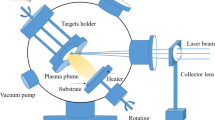Abstract
The influences of the selenium (Se) growth condition on the electronic level structure including deep defects and further on the photovoltaic conversion efficiency of antimony selenide (Sb2Se3) as the solar cell absorber layer are investigated by controlling the Se powder content during the vapor transport deposition process. The detailed characterizations including X-ray diffraction, Raman, optical absorption and photoluminescence reveal that the deep defects including the Se vacancies on the Sb2Se3 surface are largely reduced, and the efficiency of Sb2Se3 solar cells can be significantly improved, e.g., by about 31% from 5.1% to 6.7% after adding excessive Se powder during the growth process. This result may provide a basic guideline for improving the efficiency of Sb2Se3 solar cells during the growth process of the Sb2Se3 absorption layer.





Similar content being viewed by others
Data availability
All data generated or analysed during this study are included in this published article.
References
Z. Li et al., Efficiency enhancement of Sb2Se3 thin-film solar cells by the co-evaporation of Se and Sb2Se3. Appl. Phys. Express 9(5), 052302 (2016). https://doi.org/10.7567/apex.9.052302
K. Zeng, D.-J. Xue, J. Tang, Antimony selenide thin-film solar cells. Semicond. Sci. Technol. 31(6), 063001 (2016). https://doi.org/10.1088/0268-1242/31/6/063001
Y. Zhou et al., Solution-processed antimony selenide heterojunction solar cells. Adv. Energy Mater. 4(8), 1301846 (2014). https://doi.org/10.1002/aenm.201301846
M. Birkett et al., Band gap temperature-dependence of close-space sublimation grown Sb2Se3 by photo-reflectance. APL Mater. 6(8), 084901 (2018). https://doi.org/10.1063/1.5027157
J. Tao et al., Investigation of electronic transport mechanisms in Sb2Se3 thin-film solar cells. Sol. Energy Mater. Sol. Cells 197, 1–6 (2019). https://doi.org/10.1016/j.solmat.2019.04.003
L. Wang et al., Stable 6%-efficient Sb2Se3 solar cells with a ZnO buffer layer. Nat. Energy 2(4), 1–9 (2017). https://doi.org/10.1038/nenergy.2017.46
X. Liu et al., Enhanced Sb2Se3 solar cell performance through theory-guided defect control. Prog. Photovoltaics Res. Appl. 25(10), 861–870 (2017). https://doi.org/10.1002/pip.2900
M. Huang et al., Complicated and unconventional defect properties of the quasi-one-dimensional photovoltaic semiconductor Sb2Se3. ACS Appl. Mater. Interfaces. 11(17), 15564–15572 (2019). https://doi.org/10.1021/acsami.9b01220
L. Wang et al., Ambient CdCl2 treatment on CdS buffer layer for improved performance of Sb2Se3 thin film photovoltaics. Appl. Phys. Lett. 107(14), 143902 (2015). https://doi.org/10.1063/1.4932544
M. Leng et al., Selenization of Sb2Se3 absorber layer: an efficient step to improve device performance of CdS/Sb2Se3 solar cells. Appl. Phys. Lett. 105(8), 083905 (2014). https://doi.org/10.1063/1.4894170
X. Wen et al., Vapor transport deposition of antimony selenide thin film solar cells with 76% efficiency. Nat. Commun. 9(1), 1–10 (2018). https://doi.org/10.1038/s41467-018-04634-6
K. Shen et al., Efficient and stable planar n–i–p Sb2Se3 solar cells enabled by oriented 1D trigonal selenium structures. Adv. Sci. 7(16), 2001013 (2020). https://doi.org/10.1002/advs.202001013
S. Karim et al., Synthesis of gold nanowires with controlled crystallographic characteristics. Appl. Phys. A 84(4), 403–407 (2006). https://doi.org/10.1007/s00339-006-3645-6
K. Nakamura et al., Influence of CdS window layer on 2-μm thick CdS/CdTe thin film solar cells. Sol. Energy Mater. Sol. Cells 75(1–2), 185–192 (2003). https://doi.org/10.1016/s0927-0248(02)00154-x
S. Yannopoulos, K. Andrikopoulos, Raman scattering study on structural and dynamical features of noncrystalline selenium. J. Chem. Phys. 121(10), 4747–4758 (2004). https://doi.org/10.1063/1.1780151
K. Nagata, K. Ishibashi, Y. Miyamoto, Raman and infrared spectra of rhombohedral selenium. Jpn. J. Appl. Phys. 20(3), 463 (1981). https://doi.org/10.1143/jjap.20.463
J. Tauc, R. Grigorovici, A. Vancu, Optical properties and electronic structure of amorphous germanium. Phys. Status Solidi (b) 15(2), 627–637 (1966). https://doi.org/10.1002/pssb.19660150224
J. Krustok et al., The role of spatial potential fluctuations in the shape of the PL bands of multinary semiconductor compounds. Phys. Scr. 1999(T79), 179 (1999). https://doi.org/10.1238/physica.topical.079a00179
M. Grossberg et al., Origin of photoluminescence from antimony selenide. J. Alloy. Compd. 817, 152716 (2020). https://doi.org/10.1016/j.jallcom.2019.152716
Funding
This work is supported by the National Natural Science Foundation of China (61874043, 61790583, 61874045, 61775060), National Key Research and Development Program (2016YFB0501604), Shanghai Science and Technology Innovation Action Plan (21JC1402000, 19JC1416700), Aero-Science Fund (201824X8001), and Fundamental Research Funds for the Central Universities.
Author information
Authors and Affiliations
Contributions
All authors contributed to the study conception and design. Material preparation, data collection and analysis were performed by SD, FY and LS. The first draft of the manuscript was written by SD and all authors commented on previous versions of the manuscript. All authors read and approved the final manuscript.
Corresponding authors
Ethics declarations
Conflict of interest
The authors have no relevant financial or non-financial interests to disclose.
Additional information
Publisher's Note
Springer Nature remains neutral with regard to jurisdictional claims in published maps and institutional affiliations.
Rights and permissions
About this article
Cite this article
Dong, S., Sun, L. & Yue, F. Influence of selenium growth condition on the photovoltaic conversion efficiency of Sb2Se3 as the solar cell absorption layer. J Mater Sci: Mater Electron 33, 10335–10342 (2022). https://doi.org/10.1007/s10854-022-08021-2
Received:
Accepted:
Published:
Issue Date:
DOI: https://doi.org/10.1007/s10854-022-08021-2




